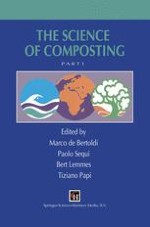1996 | OriginalPaper | Chapter
Chemical and Physico-Chemical Parameters for Quality Evaluation of Humic Substances Produced during Composting
Authors : N. Senesi, G. Brunetti
Published in: The Science of Composting
Publisher: Springer Netherlands
Included in: Professional Book Archive
Activate our intelligent search to find suitable subject content or patents.
Select sections of text to find matching patents with Artificial Intelligence. powered by
Select sections of text to find additional relevant content using AI-assisted search. powered by
The principal scope of the compo sting process is to transform organic wastes of various origins and nature into a stable, mature, humus-like material suitable for use as soil amendment. The knowledge of the quality of humic acid-like and fulvic acid-like fractions formed during the composting process is of primary importance for the evaluation of the economic value, agronomic efficacy and environmental safety of the final product, the compost, which will be applied to soil. In this review paper, the chemical and physico-chemical analytical properties and data available for the evaluation on a molecular scale of the humic acid-like and fulvic acid-like constituents in composts are summarized and discussed in comparison with indigenous soil humic acids and fulvic acids. Discussed data include elemental and functional group composition, E4/E6 ratio, molecular weight distribution, isoelectrofocusing patterns, pyrolysis-gas chromatography-mass spectra, and infrared and Fourier transform infrared, nuclear magnetic resonance, electron spin resonance and fluorescence spectra. With respect to native soil humic and fulvic acids, humic and fulvic acid-like fractions in composted sewage sludges, municipal solid wastes, animal manures and plant wastes are generally characterized by (i) higher molecular heterogeneity; (ii) lower degree of aromaticity and structural polycondensation; (iii) higher aliphatic character; (iv) marked presence of incorporated proteinaceous materials, partially modified lignin moieties and polysaccharide-like structures; and (v) lower amounts of oxygen containing and acidic. especially carboxylic, functional groups. With composting, however, a loss of Ncontaining groups, alkyl chains and carbohydrates, and an increase in oxygenation, carboxyl groups and aromaticity generally occur in fulvic acids and. especially, humic acids. This is an important result which supports the validity of the compo sting process for organic wastes in approaching the quality of humuslike components to native soil humic substances.
